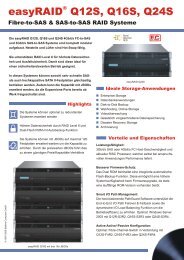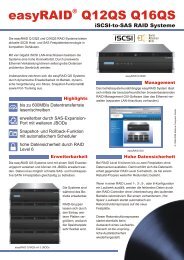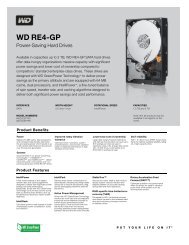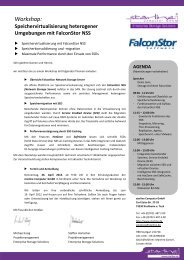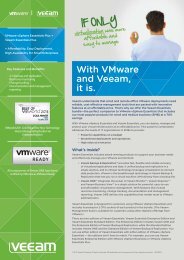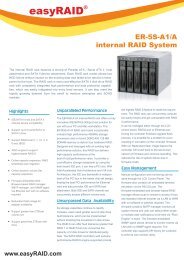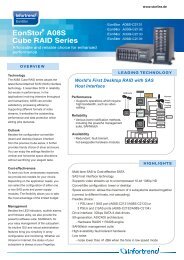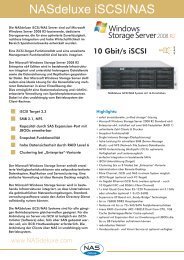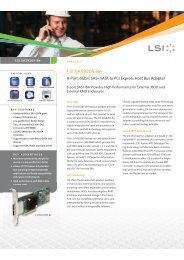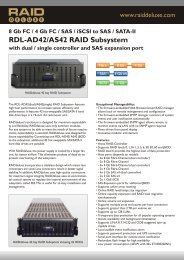Active-Active vs. Active-Passive - starline Computer GmbH
Active-Active vs. Active-Passive - starline Computer GmbH
Active-Active vs. Active-Passive - starline Computer GmbH
You also want an ePaper? Increase the reach of your titles
YUMPU automatically turns print PDFs into web optimized ePapers that Google loves.
1<br />
www.open-e.com<br />
ENTERPRISE CLASS STORAGE OS<br />
for EVERY BUSINESS<br />
Open-E DSS V7<br />
<strong>Active</strong>-<strong>Active</strong> <strong>vs</strong>. <strong>Active</strong>-<strong>Passive</strong><br />
Performance comparison of failover solutions<br />
Contents<br />
INTRODUCTION 2<br />
HIGH AVAILABILITY OVERVIEW 2<br />
ACTIVE-PASSIVE 3<br />
ACTIVE-ACTIVE 3<br />
TESTING METHODOLOGY AND FINDINGS 3<br />
ACTIVE-ACTIVE VS. ACTIVE-PASSIVE - DATA THROUGHPUT PERFORMANCE COMPARISON 4<br />
ACTIVE-ACTIVE VS. ACTIVE-PASSIVE - FAILOVER SWITCHING TIME COMPARISON 5<br />
SUMMARY 6<br />
APPENDIX A – TEST ENVIRONMENT DETAILS 7<br />
APPENDIX B – MEASURED VALUES 8
2<br />
INTRODUCTION<br />
www.open-e.com<br />
ENTERPRISE CLASS STORAGE OS<br />
for EVERY BUSINESS<br />
The purpose of this document is to compare two high availability failover configurations, namely <strong>Active</strong>-<strong>Active</strong> and <strong>Active</strong>-<br />
<strong>Passive</strong>, both being possible to configure using Open-E DSS V7 software*.<br />
The comparison was entrusted with two tests conducted by the Open-E Quality Assurance Team, measuring respectively:<br />
data throughput performance and failover switching time.<br />
Apart from presenting tests results and conclusions, this document provides brief descriptions of both configurations.<br />
.<br />
*To take advantage of <strong>Active</strong>-<strong>Active</strong> functionality, an additional Feature Pack - <strong>Active</strong>-<strong>Active</strong> iSCSI Failover of the<br />
Open-E DSS V7 software is required.<br />
HIGH AVAILABILITY OVERVIEW<br />
Last year (2011), Science magazine published an<br />
interesting study presenting measurements of world’s<br />
total technological capacity to communicate, store, and<br />
compute information.<br />
According to the publication: “in 2007, humankind was able<br />
to store 2.9 × 10 20 optimally compressed bytes and carry<br />
out 6.4 × 10 18 instructions per second on general-purpose<br />
computers”[1]. At the same time: “general-purpose<br />
computing capacity grew at an annual rate of 58%” [1].<br />
With amount of data increment at this rate, the need to<br />
effectively store data becomes a priority.<br />
Thinking of “effective” ways of storing data – the key<br />
element is continuous availability of storage solutions.<br />
Availability of resources is one of the concerns of Business<br />
Continuity. Planning involved in that field is about ensuring<br />
that companies will be able to operate in case of a serious<br />
disruption.<br />
IT components availability has become increasingly<br />
important since businesses are more and more dependent<br />
on digital information and technology.Considering<br />
industries as candidates for implementing high availability<br />
solutions, we can name healthcare, banking, online<br />
retail and many more. All of them require continuous,<br />
uninterrupted access to their resources.<br />
A standard for availability of the products or systems is<br />
known as “class of 9s”.<br />
Downtime Costs $26.5 Billion in Lost Revenue<br />
It refers to the percentage figures used for the<br />
representation of high availability (e.g. 99.999% is five<br />
nines). For example, in case of availability value of 98 %,<br />
the downtime will equal 2 %. Downtime easily translates<br />
to lost revenue.<br />
High availability is a goal for storage solutions. The priority<br />
is for data or services to be accessed at all times, even if<br />
malfunction occurs. This can be achieved in a number of<br />
ways involving clustering, redundancy and software that<br />
handles the failover configurations.<br />
High Availability clusters, with priority to decrease<br />
downtime to a minimum, are one of the implementations<br />
of these solutions. Such clusters are usually supported by<br />
storage management software and Open-E DSS V7 can be<br />
an example of those.<br />
Typically, a high availability cluster consists of two nodes.<br />
In case of a node failure, the client network connections<br />
and file systems are moved or mounted to the other node,<br />
so the downtime is minimized or eliminated completely.<br />
An operation of switching to a redundant or synchronized<br />
node is called failover. In contrast, failback is the process<br />
of restoring a system, component or service to a state<br />
before failure.<br />
There are two major configurations for implementation<br />
of high availability storage solutions – <strong>Active</strong>-<strong>Passive</strong><br />
and <strong>Active</strong>-<strong>Active</strong>. Let us briefly describe them, before<br />
presenting the results.<br />
“…more than $26.5 billion in revenue is lost each year from IT downtime, which translates to roughly $150,000 is lost<br />
annually for each business (…). Of the 200 companies surveyed, small enterprises lost, on average, more than $55,000<br />
in revenue due to IT failures each year, while midsize companies lost more than $91,000 and large companies lost<br />
more than $1,000,000.”<br />
Source: Information Week, 2011 [2].
3<br />
ACTIVE-PASSIVE<br />
An <strong>Active</strong>-<strong>Passive</strong> storage concerns the configuration of<br />
two nodes, where one of them plays the role of the primary<br />
node (active) and the other is set as standby (passive)–<br />
waiting to take over the control if necessary.<br />
The active node processes all the I/O operations and<br />
continuously synchronizes its configuration and session<br />
information with the passive device, so that in case of<br />
a failure, it will be ready to take its place.<br />
The main disadvantage of the <strong>Active</strong>-<strong>Passive</strong> configuration<br />
is that the secondary node is not operational; therefore the<br />
hardware resources are not fully utilized.<br />
With Open-E DSS V7<br />
TESTING METHODOLOGY AND FINDINGS<br />
www.open-e.com<br />
ENTERPRISE CLASS STORAGE OS<br />
for EVERY BUSINESS<br />
This paragraph presents tests that were conducted to compare the <strong>Active</strong>-<strong>Active</strong> and the <strong>Active</strong>-<strong>Passive</strong> failover<br />
configurations of Open-E DSS V7 software.<br />
The following measures were tested:<br />
1. Data throughput in both configurations.<br />
2. Failover switching time in both configurations.<br />
ACTIVE-ACTIVE<br />
In an <strong>Active</strong>-<strong>Active</strong> storage configuration, both nodes<br />
process I/O’s providing balanced access to the logical<br />
devices.<br />
In contrast, with <strong>Active</strong>-<strong>Passive</strong> configuration, neither<br />
instance is designated as primary or secondary.<br />
Both nodes are kept synchronized, so any changes to data<br />
in one node will be propagated to the other node.<br />
The synchronization is made through synchronous<br />
replication.<br />
<strong>Active</strong>-<strong>Active</strong> configuration provides disaster tolerance,<br />
so if one node fails, the other one takes over automatically<br />
and all services continue to run without interruption.<br />
The main difference in comparison with <strong>Active</strong>-<strong>Passive</strong><br />
configuration is that both nodes are in the “operational<br />
mode”, balancing read, write and replication traffic, which<br />
significantly improves overall cluster performance.<br />
» an <strong>Active</strong>-<strong>Active</strong> or <strong>Active</strong>-<strong>Passive</strong> High Availability cluster can be easily setup with reduced number<br />
of configuration steps.<br />
» the failover configuration can be made on any cluster node, without a need to setup every node separately.<br />
» failover and failback functions are simplified and re-designed.<br />
» reboot of cluster nodes is much more user friendly, allowing node to join the cluster automatically,<br />
if no error has been found.<br />
The purpose of the tests was to find out which configuration performs better in terms of managing data and handling<br />
failover processes.<br />
In all cases the test environments were configured using the Open-E DSS V7 software.<br />
> Each test section consists of a brief background description and findings.<br />
> A detailed list of hardware components and topology used in tests can be found in Appendix A.<br />
> Details of measures from both tests can be found in Appendix B.
4<br />
ACTIVE-ACTIVE VS. ACTIVE-PASSIVE -<br />
DATA THROUGHPUT PERFORMANCE COMPARISON<br />
Test Background<br />
www.open-e.com<br />
ENTERPRISE CLASS STORAGE OS<br />
for EVERY BUSINESS<br />
> To enhance the throughput performance a multipath IO between clients and storage servers (nodes) has been<br />
implemented in both configurations.<br />
> In order to achieve Zero-Single-Point-of-Failure with 2 network switches, bonding (balance-alb) of the network<br />
interfaces was applied on each node.<br />
> The performance tests with variable block sizes were performed using Iometer tool, version 2006.07.27.<br />
> Block sizes of 4 KB, 32 KB, 64 KB, 128 KB, 256 KB, 512 KB, 1 MB and 4 MB were used for the tests.<br />
> Read and write time onto raw iSCSI device for each block size was measured over a period of 90 seconds.<br />
> The results in MB/s are sums of measures received for both clients (WIN1 and WIN2) taking part in the test.<br />
Test Findings<br />
Figure 1. Write performance [MB/s] per block size (KB). Figure 2. Read performance [MB/s] per block size (KB).<br />
As indicated in figures 1 and 2, the comparison of read and write performance in both failover configurations proved an<br />
advantage of the <strong>Active</strong>-<strong>Active</strong> set up.<br />
Open-E DSS V7 in the <strong>Active</strong>-<strong>Active</strong> iSCSI Failover setup achieved up to 98 % better results in write performance than<br />
<strong>Active</strong>-<strong>Passive</strong>.<br />
Similar results were calculated for read performance, the advantage in favor of <strong>Active</strong>-<strong>Active</strong> configuration reached the<br />
maximum of 105 %.<br />
The average values for data write performance ranged from 175 MB/s, in case of the <strong>Active</strong>-<strong>Passive</strong> configuration, to 339<br />
MB/s in case of the <strong>Active</strong>-<strong>Active</strong> configuration.<br />
For data read performance average values ranged from 187 MB/s in the <strong>Active</strong>-<strong>Passive</strong> configuration, to 350 MB/s in the<br />
<strong>Active</strong>-<strong>Active</strong> configuration.<br />
The above results clearly correspond to the fact that Open-E DSS V7 in the <strong>Active</strong>-<strong>Active</strong> failover configuration better<br />
utilizes storage resources and allows for provision of data at higher speed than the <strong>Active</strong>-<strong>Passive</strong> set up.<br />
Detailed results are presented in Appendix B.
5<br />
ACTIVE-ACTIVE VS. ACTIVE-PASSIVE-<br />
FAILOVER SWITCHING TIME COMPARISON<br />
Test Background<br />
www.open-e.com<br />
ENTERPRISE CLASS STORAGE OS<br />
for EVERY BUSINESS<br />
The purpose of this test was to calculate failover switching time in both configurations, defined as time needed for data to<br />
be accessible again on the second node in case of failover.<br />
To entrust the results, different numbers of logical volumes per node were used for evaluation - 10, 20, 30, 40 and 50<br />
respectively.<br />
Test Findings<br />
Figure 3. Failover switching time in seconds per LV count.<br />
In the comparison of the <strong>Active</strong>-<strong>Active</strong> and the <strong>Active</strong>-<strong>Passive</strong> failover switching time, the <strong>Active</strong>-<strong>Active</strong> set up delivered<br />
better results proportionally to increasing the Logical Volumes count in a node.<br />
While for 10 Logical Volumes the switching times were on the same level for both configurations, with 20-30 Logical<br />
Volumes the <strong>Active</strong>-<strong>Active</strong> failover solution performed 2 seconds faster than <strong>Active</strong>-<strong>Passive</strong> failover set up and with 40-50<br />
this difference has increased to 3 seconds.<br />
Detailed results are presented in Appendix B.<br />
- LOWER MEANS BETTER!
6<br />
SUMMARY<br />
Tests Key Findings<br />
www.open-e.com<br />
ENTERPRISE CLASS STORAGE OS<br />
for EVERY BUSINESS<br />
> The Open-E DSS V7 iSCSI <strong>Active</strong>-<strong>Active</strong> Failover configuration achieved better results in data throughput performance.<br />
The difference between tested configurations was up to 105% in <strong>Active</strong>-<strong>Active</strong> failover favor. This translates to improved<br />
access to storage devices for both writing and reading data, allowing for more operations to be performed at specific<br />
period of time in case of an <strong>Active</strong>-<strong>Active</strong> configuration.<br />
> The Open-E DSS V7 iSCSI <strong>Active</strong>-<strong>Active</strong> failover configuration performs better in terms of resources switching time.<br />
The time needed to switch operation of the failing nodes was shorter than in case of <strong>Active</strong>-<strong>Passive</strong> configuration.<br />
This effectively results in minimized disruptions in case of a failure.<br />
To summarize, Open-E DSS V7 with the Feature Pack - <strong>Active</strong>-<strong>Active</strong> iSCSI Failover helps to deliver much better value than<br />
the basic <strong>Active</strong>-<strong>Passive</strong> configuration.<br />
Minimized disruptions in case of a failure, better utilized storage resources and strong performance in both storing and<br />
accessing data, confirmed in our tests, strongly speak for considering <strong>Active</strong>-<strong>Active</strong> failover configuration as an ideal<br />
solution for High Availability storages.<br />
What Open-E DSS V7 with <strong>Active</strong>-<strong>Active</strong> iSCSI Failover has to offer?<br />
» It is simple to use – while <strong>Active</strong>-<strong>Active</strong> set up is<br />
considered as complex to configure - with Open-E<br />
DSS V7 it is no longer an issue.<br />
» Eliminates wasting of hardware, all resources are in<br />
use - working towards better system performance.<br />
» Provides self-validation of the system. When starting<br />
a cluster, Open-E DSS V7 checks all the critical<br />
settings on each node. This way, clusters will not be<br />
started if they were configured wrong.<br />
» Increases sensibility for network failures, thanks to<br />
the possibility of configuring Ping Nodes.<br />
» Speeds up networking connectivity, since I/O traffic<br />
is equally balanced on two nodes.<br />
» Fully utilizes all processing power on both cluster<br />
nodes.
7<br />
APPENDIX A – TEST ENVIRONMENT DETAILS<br />
1. <strong>Active</strong>-<strong>Active</strong> <strong>vs</strong>. <strong>Active</strong>-<strong>Passive</strong> -<br />
Data Throughput Performance Comparison<br />
Hardware components details<br />
Nodes specification:<br />
CPU: Dual-core 3.10GHz processor<br />
MEM: 8GB DDR3 RAM<br />
NICs: 5x 1GbE Ethernet network adapter<br />
1x 10GbE Ethernet network adapter<br />
H/W RAID: 1x PCI-e 6GB SAS with 1GB Cache<br />
HDD: 16x 3TB SATAIII 7200RPM 64MB Cache<br />
Hardware topology<br />
Figure 4. Hardware topology in test<br />
www.open-e.com<br />
ENTERPRISE CLASS STORAGE OS<br />
for EVERY BUSINESS
8<br />
2. <strong>Active</strong>-<strong>Passive</strong> <strong>vs</strong>. <strong>Active</strong>-<strong>Active</strong> -<br />
Failover Switching Time Comparison<br />
Hardware components details<br />
Nodes specification:<br />
CPU: Dual-core 3.10GHz processor<br />
MEM: 8GB DDR3 RAM<br />
1NIC: 2x 1GbE Ethernet network adapter<br />
2NIC: 2x 10GbE Ethernet network adapter<br />
H/W RAID: 1x PCI-e 6GB SAS with 1GB Cache<br />
HDD: 16x 3TB SATAIII 7200RPM 64MB Cache<br />
APPENDIX B – MEASURED VALUES<br />
1. <strong>Active</strong>-<strong>Active</strong> <strong>vs</strong>. <strong>Active</strong>-<strong>Passive</strong> -<br />
Data Throughput Performance Comparison<br />
Table 1. Data throughput in the <strong>Active</strong>-<strong>Active</strong> configuration.<br />
www.open-e.com<br />
ENTERPRISE CLASS STORAGE OS<br />
for EVERY BUSINESS<br />
Block size <strong>Active</strong>-<strong>Active</strong> Write (MB/s) <strong>Active</strong>-<strong>Active</strong> Read (MB/s)<br />
4 K 65,21 160,24<br />
32 K 280,15 354,55<br />
64 K 328,99 382,74<br />
128 K 379,97 387,73<br />
256 K 402,59 371,47<br />
512 K 418,13 377,49<br />
1024 K 419,71 363,46<br />
4096 K 418,36 400,39<br />
Block size <strong>Active</strong>-<strong>Passive</strong> Write (MB/s) <strong>Active</strong>-<strong>Passive</strong> Read (MB/s)<br />
4 K 35,05 78,22<br />
32 K 148,15 211,54<br />
64 K 178,36 198,82<br />
128 K 196,05 197,84<br />
256 K 206,32 201,58<br />
512 K 211,00 196,20<br />
1024 K 212,02 216,57<br />
4096 K 210,98 197,10<br />
Table 2. Data throughput in the <strong>Active</strong>-<strong>Passive</strong> configuration.
9<br />
2. <strong>Active</strong>-<strong>Passive</strong> <strong>vs</strong>. <strong>Active</strong>-<strong>Active</strong> -<br />
Failover Switching Time Comparison<br />
References:<br />
Logical Volume Count<br />
Open-E DSS V7 1GbE <strong>Active</strong>-<strong>Active</strong><br />
Switching Resources Time (s)<br />
10 2<br />
20 2<br />
30 3<br />
40 4<br />
50 5<br />
Table 3. Failover switching time in the <strong>Active</strong>-<strong>Active</strong> configuration.<br />
Logical Volume Count<br />
Open-E DSS V7 1GbE <strong>Active</strong>-<strong>Passive</strong><br />
Switching Resources Time (s)<br />
10 2<br />
20 4<br />
30 5<br />
40 7<br />
50 8<br />
Table 4. Failover switching time in the <strong>Active</strong>-<strong>Passive</strong> configuration.<br />
C o m p u t e r G m b H<br />
Carl-Zeiss-Str. 27-29 • D-73230 Kirchheim / Teck<br />
Tel. +49(0)7021-487 200 • Fax +49(0)7021-487 400<br />
www.<strong>starline</strong>.de<br />
[1] Hilbert, M., Lopez, P. (2011). The World’s Technological Capacity to Store, Communicate, and Compute<br />
Information. Science 1 April 2011: Vol. 332 no. 6025 pp. 60-65. Retrieved from:<br />
http://www.sciencemag.org/content/332/6025/60.full<br />
Copyright © 2004-2012 Open-E, Inc. All rights reserved. No part of this publication may be reproduced, stored in a retrieval system, or transmitted in any form,<br />
by any means, electronic, mechanical, photocopying, recording or otherwise, without the prior written consent of Open-E, Inc.<br />
Trademarks The names of actual companies and products mentioned herein may be the trademarks of their respective owners.<br />
Disclaimer Open-E, Inc. assumes no responsibility for errors or omissions in this document, and Open-E, Inc. does not make any commitment to update the information contained herein.<br />
ENTERPRISE CLASS STORAGE OS<br />
for EVERY BUSINESS<br />
[2] Harris C., (2011). IT Downtime Costs $26.5 Billion In Lost Revenue, Information Week, Retrieved from<br />
http://www.informationweek.com/storage/disaster-recovery/it-downtime-costs-265-billion-in-lost-re/229625441<br />
www.open-e.com<br />
2012/10



